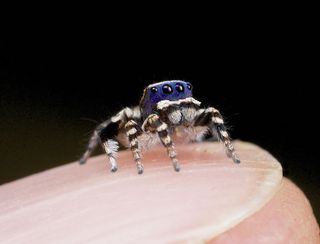Dancing Peacock Spider Is a Web Sensation

This story was updated at 3:12 p.m. ET.
If you don't think spiders are super-cute, then you've probably never seen Maratus personatus perform its very elaborate, oh-so-adorable mating dance.
The males of this newly described species of peacock spider get seriously groovy when wooing lady spiders, and, luckily for arachnophiles, one biologist thinks their dance moves are worthy of recording (and then setting to funky music). Jürgen Otto, a mite biologist and peacock spider enthusiast at the Australian Department of Agriculture in Sydney, maintains a YouTube channel devoted to sharing the mating dances of these spiders in a way that even arachnophobes can appreciate.
Otto's most recent YouTube video features the leg clapping and pedipalp shaking of one M. personatus, or Blueface peacock spider — a species first discovered back in 2013. Otto and his colleague, David Hill, a spider researcher in South Carolina, described this little critter for the first time last week (July 28) in the open-access journal Peckhamia. [See Incredible Photos of Peacock Spiders]
There are a lot of reasons why M. personatus could be called cute. For one thing, it's tiny. Males are only about an eighth of an inch long (they range in size from 0.15 to 0.18 inches, or 3.84 to 4.59 millimeters). Then there's the whole superhero mask thing they have going on; males have a blue band encircling their heads that contrasts nicely with the black-and-white stripes lining the rest of the body.
Add to all that some big, bulbous eyeballs and what you get is a spider that anyone could love. It also doesn't hurt that Blueface is so small that its fangs can't pierce human skin, rendering it completely harmless to humans, Otto told Live Science in an email. However, if the spider's appearance doesn't win you over, its dance moves certainly will.
To get a female to notice him, a Blueface male raises one set of legs over his body while scuttling back and forth in front of his love, Otto and Hill found in their study of the newfound spider. The male's front appendages, or pedipalps, move rapidly as he tries to enchant the female with his slick moves. Unlike some peacock spiders, M. personatus doesn't resort to belly dancing (otherwise known as fan extending) to get the girl. If his dance doesn't attract a female, he has his attractive coloring — which is also meant to help him lure the ladies — to fall back on.
Sign up for the Live Science daily newsletter now
Get the world’s most fascinating discoveries delivered straight to your inbox.

But the elaborate mating dances of peacock spiders aren't just cute: They're downright incredible, Otto told Live Science in 2013.
"People associate complex behavior usually with large animals, usually vertebrates [animals with backbones], so it is very unexpected to see a similar behavior in much smaller invertebrates, in particular spiders that most people hate so much," Otto said in the Live Science interview.
The biologist said he first became interested in recording the behaviors of these spiders after hiking in bushland near Sydney, where all eight of the 40 known species of peacock spiders live (the other species are endemic to other parts of Australia). Otto was surprised by the nimbleness with which the small spiders jumped. It wasn’t until later that he learned of their awe-inspiring mating rituals and decided that someone ought to film them.
Earlier this year, Otto co-authored a report describing two more species of peacock spiders, Maratus jactatus and Maratus sceletus. Nicknamed Sparklemuffin and Skeletorus, respectively, these two colorful arachnids exhibit some pretty awesome dance moves of their own. A male Skeletorus even adds a little something extra to the courtship dance — he flexes a leg as if showing off his muscles, Otto told Live Science in February.
Editor's Note: This story was updated to correctly list the number of known peacock spider species as 40 (including Blueface) and to acknowledge that only eight of these species reside in the bushland near Sydney.
Follow Elizabeth Palermo @techEpalermo. Follow Live Science @livescience, Facebook & Google+. Original article on Live Science.

Elizabeth is a former Live Science associate editor and current director of audience development at the Chamber of Commerce. She graduated with a bachelor of arts degree from George Washington University. Elizabeth has traveled throughout the Americas, studying political systems and indigenous cultures and teaching English to students of all ages.
